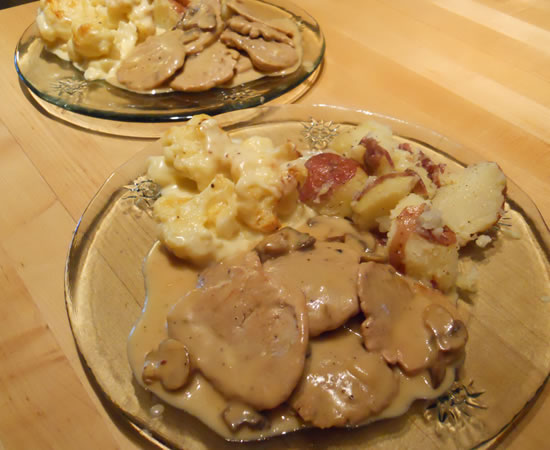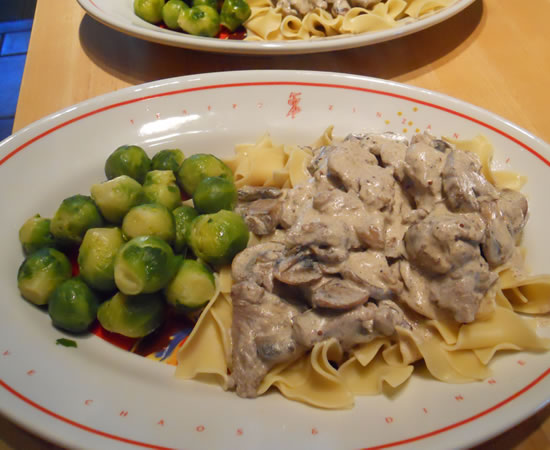
I’ve come to the conclusion that I hate writing out recipes.
I still love cooking and creating and all that, but the actual process of sitting down and trying to write out what I think I may have done for dinner is actually difficult. My measuring skills are imprecise at best. Well… not exactly true. If something calls for a half-cup of milk, raisins – whatever – I can eyeball a pretty precise half-cup. But if I’m making a sauce for scallops of pork tenderloin… Was it a half-cup? Three-quarters? I dunno. The finished result was a smooth, creamy sauce. I can tell you the ingredients, but amounts vary.
I used to love creating recipes commercially – the real science behind cooking. And taking a base recipe and expanding it to 20 – or 200 portions. I first learned the concept from the AFRCS – The Armed Forces Recipe Card Service. It was relatively new when I was in Uncle Sam’s Yacht Club. Standardized recipes printed on cards set up in 100-portion quantities. One of the first things we learned in “A” School was to multiply them out to 5000 people – or to divide them down to 30. It was only through working with the recipes that one learned how to manually adjust things like baking powder or yeast – and salt and other spices. Even though ingredients are the same proportionally, they do not multiply out. A quarter-cup of salt in a recipe for 100 would not call for 12 1/2 cups of salt for 5000. Trust me on this.
And speaking of varying… You’ve surely noticed the trend in many cooking magazines to give you the weight of some ingredients in place of measurements. The theory – according to the magazine publishers – is because of the variables in measuring. They wish to be precise.
However… the recipes generally will state something like “15 1/2 oz flour (3 1/2 cups)” yadayadayada ingredients, and then state something like “1 cup water, or more.” with instructions to add the 1 cup and then add more, 1 tbsp at a time, to get the desired consistency.
HELLO?!? Where is your “precision” now?!? I certainly understand the science of baking vs the art of cooking. The variables in baking are legion. They include the type of flour, the moisture content of the flour, the weather and relative humidity along with in cake baking – the proper ratio of flour, sugar, eggs, and fat…
But if the recipe calls for weighing your flour – approx 4 1/2 oz per cup – and NOT weighing your sugar – about 7 oz per cup – it’s nothing more than something written by an elitist snob. Be precise – or within acceptable guidelines – but please don’t pretend a precision that isn’t true. Whether it be 3 1/2 cups of flour or 15 1/2 ounces, you still have as much as a 20% variable to play with within the traditional parameters. Generally speaking, a teaspoon of flour either way is probably not going to ruin your cake.
Rant over. For the moment.
So for those lovely pork scallops up there?
Really easy.
I sliced a pork tenderloin and then pounded the slices between sheets of plastic wrap with my wooden mallet. I sauteed them in a bit of butter and olive oil and then removed them from the pan. I added sliced mushrooms and browned them well, and then added a splash of sherry. I then added a splash of chicken broth and a splash of heavy cream. I cooked it all down, added the pork scallops back, and heated it all through. If it seems too thin, you could add a bit of cornstarch.
As a side dish, I did cauliflower in a cheese sauce, baked in the oven. No crumbs on top, but it was yummy.
And then Sunday…

Beef Stroganoff.
I bought a whole tenderloin a while back and after cutting up steaks and a roast, set the tail, chain, and other smaller pieces aside for a stew or something. The something was stroganoff. A really simple recipe that literally just takes minutes to prepare.
The beef doesn’t get a lot of cooking or braising time, so you want to use something reasonably tender. I sauteed beef and mushrooms, added a splash of marsala, a pinch of sage, about a cup of sour cream, and a teaspoon of grainy dijon mustard. I heated it all through and served it over wide egg noodles.
The whole dish was cooked in the time it took to boil the water for the noodles.
Simplicity.
